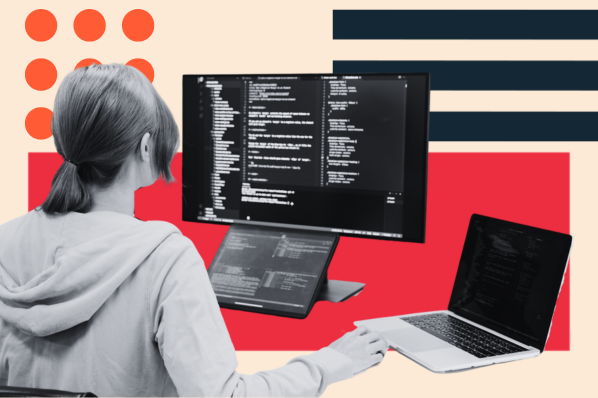As organizations are shifting to data-driven cultures, they are also finding new ways to leverage data for smarter decisions and better business outcomes. A primary focus for many companies is on artificial intelligence (AI) and machine learning (ML) and how these technologies can unlock insights buried deep in their data. At their height, AI and ML provide predictive intelligence to optimize operations and adjust strategies based on real-time trends.

However, AI and ML don't simply happen overnight. They require a careful and measured approach to achieve the algorithms necessary to power predictive analytics and effectively roll them out to the organization.
To kickstart this process, organizations are turning to a battle-proven approach to software development, DevOps, and retooling its model for the creation of AI and ML applications. The result is commonly referred to as MLOps. This post will cover the MLOps lifecycle, how it compares to DevOps, and the best practices and challenges for teams implementing MLOps.
What is MLOps?
Machine learning DevOps (MLOps) is a specialized subset of DevOps tailored to produce ML applications. Like DevOps, MLOps is both a technological and cultural shift that requires the right people, processes, and tools to successfully implement. Both models deliver better software faster and in a repeatable process.
MLOps vs. DevOps
DevOps is an evolution of the agile approach to development that combines the development and operations teams into one unit: the DevOps team. Where before the development team would hand off the application for the operations team to run, now engineers from both disciplines work together for a smooth flow from software planning and creation to deployment and operation.
-1.png?width=650&name=Machine%20Learning%20DevOps%20(V4)-1.png)
With MLOps, the basic workflow and goal are the same. However, the emphasis on machine learning projects does introduce new requirements and nuances that DevOps' focus on general software applications does not incorporate.
The main difference between MLOps and DevOps is that MLOps adds an additional phase to the DevOps lifecycle. This phase focuses on the machine learning requirements and involves locating relevant data and training the algorithm on these data sets to return accurate predictions.
.png?width=650&name=Machine%20Learning%20DevOps%20(V4).png)
Otherwise, if no suitable data sets can be found or the algorithm cannot be trained to deliver the needed results, then there is no point in continuing the development and operations phases.
Other differences between MLOps and DevOps center on the fact that data is the main focus of the application, so data scientists take the place of software developers in MLOps. They are responsible for locating relevant data, writing the code that builds the ML model, and training the model to produce the expected results. Once the model is validated and the application is ready to deploy, it is handed off to ML engineers to launch and monitor.
In addition, version control now extends not only to the code but to the data sets used for analysis and the model's findings. All these components are required to answer any questions on how the model returned a result for auditing purposes.
Finally, monitoring the live application is important not only to ensure availability and performance like in the DevOps model. Under MLOps, engineers also need to watch for model drift, which is when new data no longer fits the model's expectations and skews results. To combat this, ML models need to be retrained regularly.
This video from Kineto Klub reviews the definition of MLOps and how it compares to DevOps:
Now that you understand the differences between DevOps and MLOps, let's examine some best practices for teams transitioning to an MLOps model.
MLOps Best Practices
The following best practices will help your team be more effective in the MLOps lifecycle.
Reusability
DevOps places a heavy emphasis on repeatable processes, and MLOps follows the same workflow. Following a common framework between projects improves consistency and helps teams move faster because they are starting from familiar ground. Project templates provide this structure while still allowing for customization to meet each use case's unique requirements.
In addition, central data management speeds the discovery and training phases of MLOps by consolidating organizational data. Common strategies for achieving this centralization include data warehousing and the single source of truth approach.
Ethical Considerations
A consistent challenge in AI and ML models is the perpetuation of bias. If ethical principles aren't applied from the outset of the project, these models can return results with the same bias as contained in the data sets they are trained on.
Maintaining awareness around how prejudice can exist in certain situations and how that can be reflected in data will help the team correct against any biased outcomes when training and operating the model.
Resource Sharing and Collaboration
Highly collaborative and integrated pipelines like MLOps cannot function effectively with siloes. This makes it critical to foster a culture of resource sharing and collaboration in your team. Lessons learned from each project cycle should be captured and disseminated so the entire team can adjust their strategies for the next sprint.
To facilitate this knowledge sharing, documentation should be standardized and made accessible in a wiki or other centralized repository so that current and future teammates can learn the team's best practices. These records also provide a reference for how your organization's MLOps strategy has evolved.
Specialized Roles
Successful MLOps pipelines rely heavily on data scientists and machine learning engineers to build, deploy, and operate machine learning applications. The data scientist must bring deep expertise in practical applications of data and the organization's data sets. The machine learning engineer must have both data and IT operations skills, including security and architecture considerations.
Given the broad skills and experience necessary, it is more effective to onboard or transition full-time employees to ensure the many duties of these roles are supported versus trying to add these responsibilities to another data professional's job description.
Challenges for MLOps Implementation
Though MLOps offers a repeatable and efficient pathway to achieve predictive intelligence for your business, it also comes with challenges to consider when implementing an MLOps model.
1. Feasibility is dictated by data.
A major reason that the data collection and training phases have been added to the traditional DevOps pipeline is that these are a prerequisite before building the application. You may find that the questions you are looking to answer with the ML model can't be answered with the data available to your organization. Or, the model can't be trained to return reliable results.
In either case, there is no point in moving forward when the building blocks of the ML model are not present. Always keep in mind that feasibility is dictated by the data and that not every project will reach the finish line. It's better to have fewer but more trusted models than to produce unreliable insights for your organization.
2. Monitoring is more crucial to ensure predictions remain reliable.
As discussed before, model drift is a serious concern in ML applications. Data trends can change over time, and with many organizations building data pipelines with the ability to stream data in real-time, that change can happen in a matter of seconds.
Strong monitoring strategies will help ML engineers initiate retraining to prevent model drift before predictions are too heavily skewed. Monitoring also mitigates the more traditional concerns of outages and performance loss that are the focus of the DevOps model.
3. Deep data expertise is needed to achieve the best results.
Though both play a critical role in MLOps, data scientists outweigh machine learning engineers in some respects. Why? Because the initial phases of data collection and model training will make or break the project.
Deep data expertise goes beyond knowing data types and ML algorithms, though these are certainly important. The data scientist needs to understand the catalog of data available in the organization and which data sets are better suited to certain questions than others.
They will also determine the best model designs to use and how the model should interpret different trends in the data. This not only decides whether an MLOps application can move forward but will also directly affect how reliable the insights provided by the model are in the long run.
MLOps provides the path to advanced analytics.
As organizations look for new ways to leverage the vast amounts of data produced and collected every day, they are turning to advanced use cases like AI and ML. To achieve the predictive intelligence these technologies offer, they have repurposed their existing DevOps workflows into new MLOps models. Though this transition poses challenges, with established best practices and a focus on quality data, MLOps offers a viable pathway to produce advanced insights for your organization at scale.











![Top Bottlenecks for Building Effective DevOps Infrastructure [+ How to Avoid Them]](https://blog.hubspot.com/hubfs/devops%20infrastructure%20%281%29.jpg)